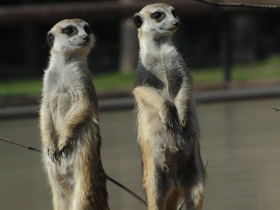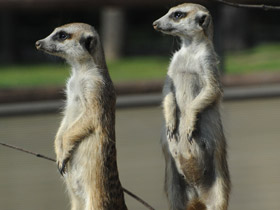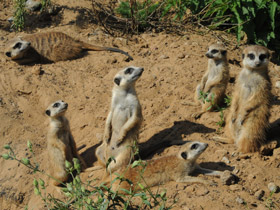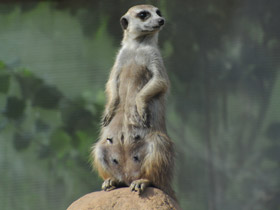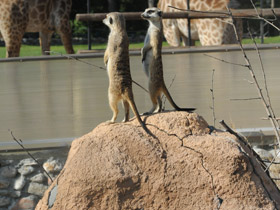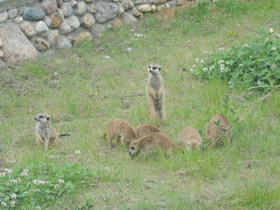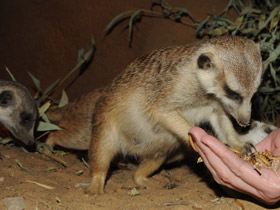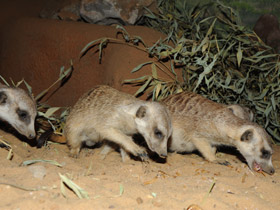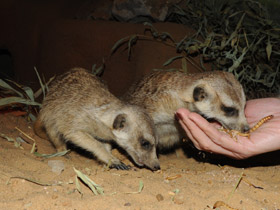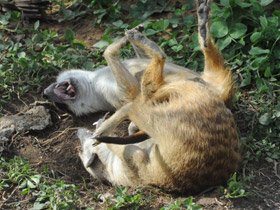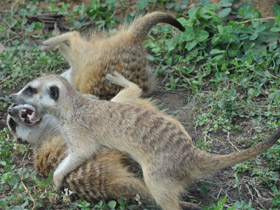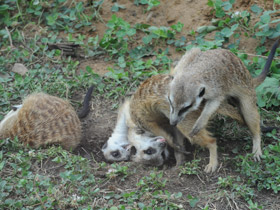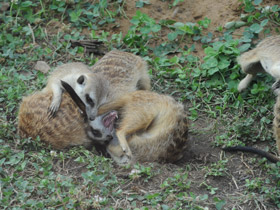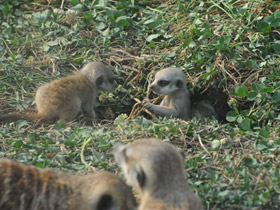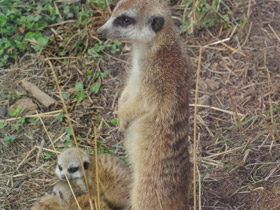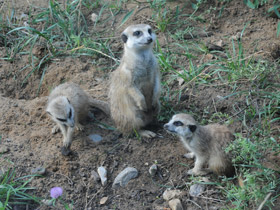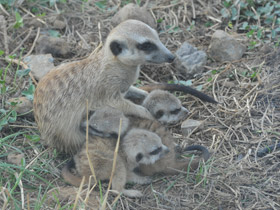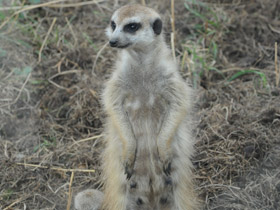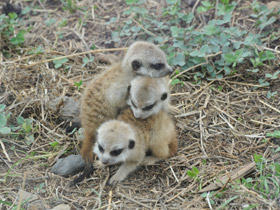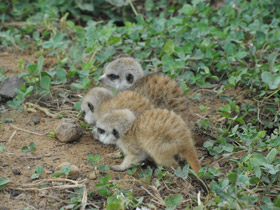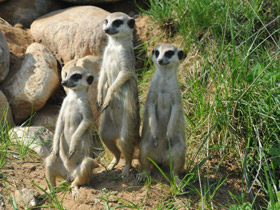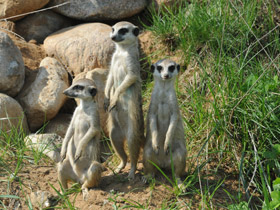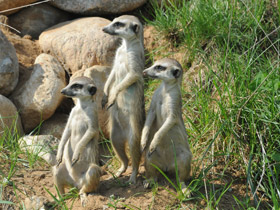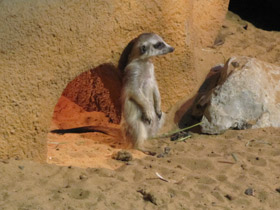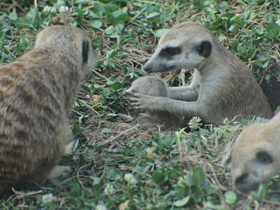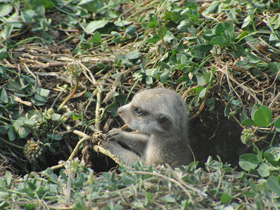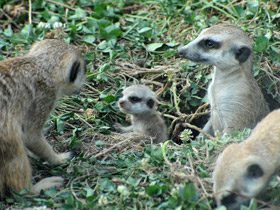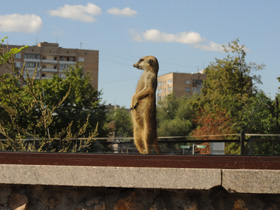The meerkat or suricate (Suricata suricatta)
Meerkat видео
The meerkat (Suricata suricatta) or suricate is a small mongoose found in southern Africa. It is characterised by a broad head, large eyes, a pointed snout, long legs, a thin tapering tail, and a brindled coat pattern. The coat is light grey to yellowish-brown with alternate, poorly-defined light and dark bands on the back. Meerkats have foreclaws adapted for digging and have the ability to thermoregulate to survive in their harsh, dry habitat. Three subspecies are recognised.
Description
Meerkat Suricata suricatta is a species of carnivorous mammal in the family Herpestidae. Meerkats are surprisingly graceful and graceful animals weighing no more than 1 kg. Their body length (about 30 cm) is almost equal to that of their muscular tail, which helps them maintain their balance and supports them in their preferred perching position (photos 1 and 2).
The meerkat note has long, slender legs with strong claws that it uses to dig deep burrows and forage for food.
Meerkats are social animals and live in colonies of 20-30 individuals comprising two or three family groups (photo 3). Mutual aid is well developed within a colony, but meerkat notes are very hostile towards members of other colonies, and fights over territory or unoccupied burrows frequently occur between different family clans.
Nutrition
Meerkats are omnivorous and are constantly on the move in search of food: they scavenge rocks, look under logs, climb trees and rocks in search of scorpions, beetles, grasshoppers, insect larvae, small rodents, bird eggs, chicks, lizards and even snakes. However, insects are the mainstay of their diet (photos 7, 8, 9) and meerkats even have special chewing surfaces on their teeth to crush their hard chitinous shells (other carnivores do not). In the desert, meerkats get by without water: their bodies extract moisture from fatty insects, juicy fruits and bulbs. While the whole colony forages for food, a meerkat serves as a sentinel. It climbs a high rock or termite mound and watches its surroundings (photos 4, 5, 6). If the sentinel notices danger, e.g. a bird of prey, it calls out sharply and all the members of the flock run to the nearest burrow.
Ecology and behaviour
The meerkat is a social mammal, forming packs of two to 30 individuals each comprising nearly equal numbers of either sex and multiple family units of pairs and their offspring. Members of a pack take turns at jobs such as looking after pups and keeping a lookout for predators. Meerkats are a cooperatively breeding species—typically the dominant 'breeders' in a pack produce offspring, and the nonbreeding, subordinate 'helpers' provide altruistic care for the pups. This division of labour is not as strictly defined as it is in specialised eusocial species, such as the breeder-worker distinction in ants. Moreover, meerkats have a clear dominance hierarchy with older individuals having a higher social status. A study showed that dominant individuals can contribute more to offspring care when fewer helpers were available; subordinate members increased their contributions if they could forage better.
Packs live in rock crevices in stony areas and in large burrow systems in plains. A pack generally occupies a home range, 5 km2 (1.9 sq mi) large on average but sometimes as big as 15 km2 (5.8 sq mi), containing many burrows 50 to 100 m (160 to 330 ft) apart, of which some remain unused. A 2019 study showed that large burrows towards the centre of a range are preferred over smaller ones located near the periphery; this was especially the case with packs that had pups to raise. A pack may shift to another burrow if the dominant female has little success finding prey in an area. The area near the periphery of home ranges is scent marked mostly by the dominant individuals; there are communal latrines, 1 km2 (0.39 sq mi) large, close to the burrows. Packs can migrate collectively in search of food, to escape high predator pressure and during floods.
Meerkats are highly vigilant, and frequently survey their surroundings by turning their heads side to side; some individuals always stand sentry and look out for danger. Vocal communication is used frequently in different contexts; for instance repetitive, high-pitched barks are used to warn others of predators nearby. They will generally retreat to their burrows for safety, where they will remain until the danger is gone. They stick their heads out of burrows to check the area outside, still barking. Mobs of meerkats fiercely attack snakes that may come near them. Raptors such as bateleurs, martial eagles, tawny eagles, and pale chanting goshawks are major aerial predators; on the ground, meerkats may be threatened by bat-eared foxes, black-backed jackals, and Cape foxes.
Social behaviour
Encounters between members of different packs are highly aggressive, leading to severe injuries and often deaths; 19% of meerkats die by conspecific violence, which is the highest recorded percentage among mammals. Females, often the heaviest ones, try to achieve dominance over the rest in many ways such as fierce competition or taking over from the leader of the pack. A study showed that females who grew faster were more likely to assert dominance, though males did not show such a trend. Males seeking dominance over groups tend to scent mark extensively and are not submissive; they often drive out older males in a group and take over the pack themselves. Subordinate individuals face difficulties in breeding successfully; for instance, dominant females often kill the litters of subordinate ones. As such, subordinate individuals might disperse to other packs to find mates during the breeding season. Some subordinate meerkats will even kill the pups of dominant members in order to improve their own offspring's position. It can take days for emigrants to secure entry into other packs, and they often face aversion from the members. Males typically succeed in joining existing groups; they often inspect other packs and their burrow systems in search of breeding opportunities. Many often team up in 'coalitions' for as long as two months and travel nearly 5 km (3.1 mi) a day on twisted paths. Dispersal appears to be less common in females, possibly because continuing to stay within a pack can eventually win them dominance over other members. Dispersed females travel longer than coalitions, and tend to start groups of their own or join other similar females; they aim for groups of emigrant males or those without a breeding female. Subordinate females, unlike subordinate males, might be ousted from their packs, especially in the latter part of the dominant female's pregnancy, though they may be allowed to return after the birth of the pups.
Reproduction
Two to five naked and blind cubs are born underground, in one of the nesting chambers of the family den. The pups' eyes open at 10-14 days, at three weeks of age they taste the adults' food, and after another 2 months they begin to eat together with the adults (photo 17, 18, 19, 20). 80% of the pups in the colony are offspring of the dominant female. Her older sisters and daughters do not breed, but take turns to nurse when she leaves her den to feed. Some childless females even start producing milk, in order to help feed their young. However, they often do not have time to eat on their own and may lose up to 10% of their weight. Almost all clan members (photo 14, 15, 16) are involved in teaching and caring for the small meerkat notes. They are taught to hunt, to hide and to understand the signals exchanged by the adults.
A considerable portion of the meerkats' prey is deadly - venomous snakes, large spiders and scorpions - so the adults spend a lot of time and effort teaching their cubs how to handle them. The elders first bring them prey that has already been killed, and then bring them live prey that is less and less traumatised. If a sentry signal indicates danger, at least one of the handlers will always make sure that the cubs also take refuge in the den. During daytime rest the careless young meerkats play, fight and try to dig burrows (photo 10, 11, 12, 13).
Vocalisations
Meerkats have a broad vocal repertoire that they use to communicate among one another in several contexts; many of these calls may be combined by repetition of the same call or mixing different sounds. A study recorded 12 different types of call combinations used in different situations such as guarding against predators, caring for young, digging, sunbathing, huddling together and aggression.
Short-range 'close calls' are produced while foraging and after scanning the vicinity for predators. 'Recruitment calls' can be produced to collect meerkats on sighting a snake or to investigate excrement or hair samples of predators or unfamiliar meerkats. 'Alarm calls' are given out on detecting predators. All these calls differ in their acoustic characteristics, and can evoke different responses in the 'receivers' (meerkats who hear the call); generally the greater the urgency of the scenario in which the call is given, the stronger is the response in the receivers.
This indicates that meerkats are able to perceive the nature of the risk and the degree of urgency from the acoustics of a call, transmit it and respond accordingly. For instance, upon hearing a terrestrial predator alarm call, meerkats are most likely to scan the area and move towards the source of the call, while an aerial predator alarm call would most likely cause them to crouch down. A recruitment call would cause receivers to raise their tails (and often their hair) and move slowly towards the source.
The complexity of calls produced by different mongooses varies by their social structure and ecology. For instance eusocial mongooses such as meerkats and banded mongooses use calls in a greater variety of contexts than do the solitary slender mongooses. Moreover, meerkats have more call types than do banded mongooses. Meerkat calls carry information to identify the signaling individual or pack, but meerkats do not appear to differentiate between calls from different sources. The calls of banded mongooses also carry a 'vocal signature' to identify the caller.
Etymology
The word 'meerkat' derives from the Dutch name for a kind of monkey, which in turn comes from the Old High German mericazza, possibly as a combination of meer ('lake') and kat ('cat'). This may be related to the similar Hindi: मर्कट (markat, or monkey), deriving from Sanskrit, though the Germanic origin of the word predates any known connections to India. The name was used for small mammals in South Africa from 1801 onward, possibly because the Dutch colonialists used the name in reference to many burrowing animals. The native South African name for the meerkat is 'suricate', possibly deriving from the French 'surikate', which in turn may have a Dutch origin. In Afrikaans the meerkat is called graatjiemeerkat or stokstertmeerkat; the term mierkatte or meerkatte can refer to both the meerkat and the yellow mongoose (Afrikaans: rooimeerkat). In colloquial Afrikaans mier means 'ant' and kat means 'cat', hence the name probably refers to the meerkat's association with termite mounds.
Taxonomy
In 1776, Johann Christian Daniel von Schreber described a meerkat from the Cape of Good Hope, giving it the scientific name Viverra suricatta. The generic name Suricata was proposed by Anselme Gaëtan Desmarest in 1804, who also described a zoological specimen from the Cape of Good Hope. The present scientific name Suricata suricatta was first used by Oldfield Thomas and Harold Schwann in 1905 when they described a specimen collected at Wakkerstroom. They suggested there were four local meerkat races in the Cape and Deelfontein, Grahamstown, Orange River Colony and southern Transvaal, and Klipfontein respectively. Several zoological specimens were described between the late 18th and 20th centuries, of which three are recognised as valid subspecies:
- Suricata suricatta suricatta (Schreber, 1776) occurs in southern Namibia, southern Botswana, and South Africa.
- Suricata suricatta majoriae Bradfield, 1936 occurs in central and northwestern Namibia.
- Suricata suricatta iona Crawford-Cabral, 1971 occurs in southwestern Angola.
Distribution and habitat
The meerkat occurs in southwestern Botswana, western and southern Namibia, northern and western South Africa; the range barely extends into southwestern Angola. It lives in areas with stony, often calcareous ground in a variety of arid, open habitats with little woody vegetation. It is common in savannahs, open plains and rocky areas beside dry rivers in biomes such as the Fynbos and the Karoo, where the mean yearly rainfall is below 600 mm (24 in). The average precipitation reduces to 100 to 400 mm (3.9 to 15.7 in) towards the northwestern areas of the range. It prefers areas with short grasses and shrubs common in velds, such as camelthorn in Namibia and Acacia in the Kalahari. It is absent from true deserts, montane regions and forests. Population densities vary greatly between places, and are significantly influenced by predators and rainfall. For instance, a study in the Kgalagadi Transfrontier Park, where predation pressure is high, recorded a lower mean meerkat density relative to a ranch with lower occurrence of predators; in response to a 10% decrease in rainfall over a year, the density fell from 0.95 to 0.32/km2 (2.46 to 0.83/sq mi).
Threats and conservation
The meerkat is listed as Least Concern on the IUCN Red List; the population trend appears to be stable. There are no significant threats except low rainfall, which can lead to deaths of entire packs. Research has shown that temperature extremes have negative impacts on Kalahari Desert meerkats. Increased maximum air temperature is correlated with decreased survival and body mass in pups, perhaps as a result of dehydration from water loss during evaporative cooling or decreased water content in food, or from the heavier metabolic costs of thermoregulation on hot days. Higher temperatures are also associated with increased rates of endemic tuberculosis infection; this may be due to decreased immune function resulting from physiological stress, as well as increased male emigration rates observed during heat waves.
Meerkats occur in several protected areas such as the Kgalagadi Transfrontier Park and the Makgadikgadi Pan. The Kalahari Meerkat Project, founded by Tim Clutton-Brock, is a long-term research project run by four different research groups that focuses on understanding cooperative behaviour in meerkats. It began in the Gemsbok National Park but was shifted to the Kuruman River Reserve in 1993.
Meerkats are generally tame animals. However, they are unsuitable as a pet as they can be aggressive and have a strong, ferret-like odour. In South Africa meerkats are used to kill rodents in rural households and lepidopterans in farmlands. Meerkats can transmit rabies to humans, but yellow mongooses appear to be more common vectors. It has been suggested that meerkats may even limit the spread of rabies by driving out yellow mongooses from their burrows; meerkats are generally not persecuted given their economic significance in crop protection, though they may be killed due to rabies control measures to eliminate yellow mongooses. Meerkats can also spread tick-borne diseases.

















